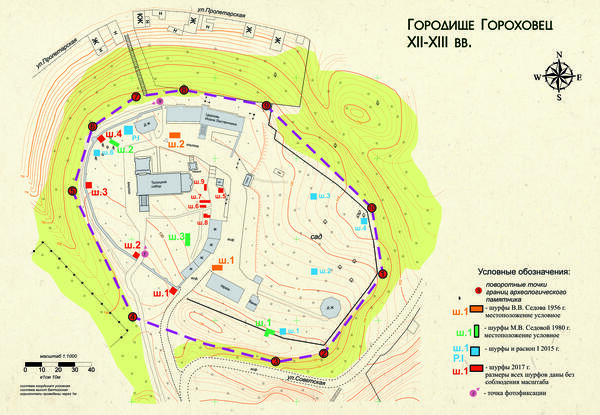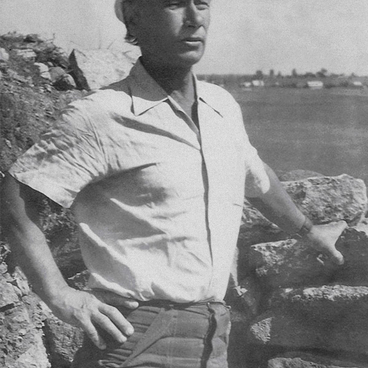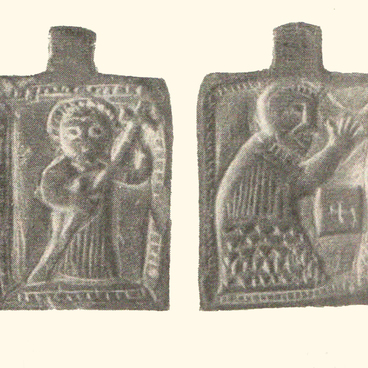The ancient settlement of Gorokhovets is located on the headland of the right bank of the Klyazma River. Outside the fortifications are a posad (a settlement, often surrounded by ramparts and a moat) and a burial ground. The first archaeological research on the site of the settlement was led by Valentin Vasilyevich Sedov in 1956.
24 years later, Sedov’s wife Mariya Vladimirovna Sedova started exploring the settlement. In 1991, Viktor Petrovich Glazov studied the cultural deposit of the area. In 2015, the research on the location was carried out by the expedition of the Institute of Archaeology of the Russian Academy of Sciences, which set out to determine the boundaries of the settlement and the group of kurgans.
Over the years, the area that was studied using exploratory shafts, that is, small pits, amounted to 112 square meters. It turned out that the settlement occupies the entire headland, which was formed by an extensive ravine system. Its height varies from 40 to 50 meters above the river.
The site of the settlement is oval in plan. Its landscape gradually lowers from the southwest to the east-northeast. The terrain of the site is complex. There were traces of numerous terraces and cuttings that were linked to land leveling works, which began in the 17th century.
There is an opinion that the settlement had fortifications along its entire perimeter. In the southeastern part, in front of the surviving fortifications are the remains of a moat, which lead to two converging ravines. Their upper parts have a flat area up to 30 meters wide in between them. This might have been the entrance to the settlement territory.
In the 12th century, similar settlements appeared across the Grand Duchy of Vladimir. The cultural deposit is about one meter thick. Glass beads, bracelets, and ceramics were found in the area. Of particular interest is a stone icon, excavated in 1956.
It has a rectangular shape. One of its sides depicts a saint with a halo, the other — a kneeling man in profile. Tatyana Vasilyevna Nikolayeva, a researcher of ancient Russian small statuary, dated the icon to the first quarter of the 13th century, and the figures depicted on it were recognized as John the Baptist with a cross and John the Apostle.
24 years later, Sedov’s wife Mariya Vladimirovna Sedova started exploring the settlement. In 1991, Viktor Petrovich Glazov studied the cultural deposit of the area. In 2015, the research on the location was carried out by the expedition of the Institute of Archaeology of the Russian Academy of Sciences, which set out to determine the boundaries of the settlement and the group of kurgans.
Over the years, the area that was studied using exploratory shafts, that is, small pits, amounted to 112 square meters. It turned out that the settlement occupies the entire headland, which was formed by an extensive ravine system. Its height varies from 40 to 50 meters above the river.
The site of the settlement is oval in plan. Its landscape gradually lowers from the southwest to the east-northeast. The terrain of the site is complex. There were traces of numerous terraces and cuttings that were linked to land leveling works, which began in the 17th century.
There is an opinion that the settlement had fortifications along its entire perimeter. In the southeastern part, in front of the surviving fortifications are the remains of a moat, which lead to two converging ravines. Their upper parts have a flat area up to 30 meters wide in between them. This might have been the entrance to the settlement territory.
In the 12th century, similar settlements appeared across the Grand Duchy of Vladimir. The cultural deposit is about one meter thick. Glass beads, bracelets, and ceramics were found in the area. Of particular interest is a stone icon, excavated in 1956.
It has a rectangular shape. One of its sides depicts a saint with a halo, the other — a kneeling man in profile. Tatyana Vasilyevna Nikolayeva, a researcher of ancient Russian small statuary, dated the icon to the first quarter of the 13th century, and the figures depicted on it were recognized as John the Baptist with a cross and John the Apostle.



